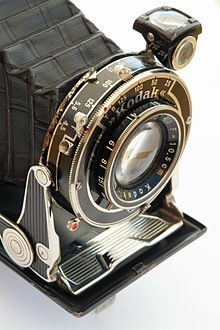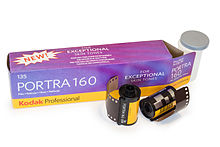
A digital camera is a camera that captures photographs in digital memory. Most cameras produced today are digital, largely replacing those that capture images on photographic film. Digital cameras are now widely incorporated into mobile devices like smartphones with the same or more capabilities and features of dedicated cameras. High-end, high-definition dedicated cameras are still commonly used by professionals and those who desire to take higher-quality photographs.

Konica Minolta, Inc. is a Japanese multinational technology company headquartered in Marunouchi, Chiyoda, Tokyo, with offices in 49 countries worldwide. The company manufactures business and industrial imaging products, including copiers, laser printers, multi-functional peripherals (MFPs) and digital print systems for the production printing market. Konica Minolta's Managed Print Service (MPS) is called Optimised Print Services. The company also makes optical devices, including lenses and LCD film; medical and graphic imaging products, such as X-ray image processing systems, colour proofing systems, and X-ray film; photometers, 3-D digitizers, and other sensing products; and textile printers. It once had camera and photo operations inherited from Konica and Minolta but they were sold in 2006 to Sony, with Sony's Alpha series being the successor SLR division brand.

The Ricoh Company, Ltd. is a Japanese multinational imaging and electronics company. It was founded by the now-defunct commercial division of the Institute of Physical and Chemical Research (Riken) known as the Riken Concern, on 6 February 1936 as Riken Sensitized Paper. Ricoh's headquarters are located in Ota, Tokyo.
Konica was a Japanese manufacturer of, among other products, film, film cameras, camera accessories, photographic and photo-processing equipment, photocopiers, fax machines and laser printers, founded in 1873. The company merged with Japanese peer Minolta in 2003, with the new company named Konica Minolta.
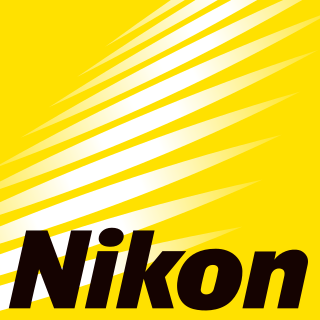
Nikon Corporation, also known just as Nikon, is a Japanese multinational corporation headquartered in Tokyo, Japan, specializing in optics and imaging products. The companies held by Nikon form the Nikon Group.

Kodak EasyShare is a sub brand of Eastman Kodak Company products identifying a consumer photography system of digital cameras, snapshot thermal printers, snapshot thermal printer docks, all-in-one inkjet printers, accessories, camera docks, software, and online print services. The brand was introduced in 2001. The brand is no longer applied to all-in-one inkjet printers or online printing services. Thermal snapshot printers and printer docks product lines have been discontinued. In 2012, Kodak stopped manufacturing and selling all digital cameras and photo frames.
The Kodak DX6440 is a model of digital camera produced by the Eastman Kodak Company. It is part of the company's EasyShare consumer line of cameras, and is compatible with the Kodak camera docks and printer docks. Its 1/2.5" CCD image sensor gives a 4 megapixel image, while the fully retractable Schneider-Kreuznach lens has a focal length range equivalent to 33mm–132mm on a 135 film camera, which is a 4× range.
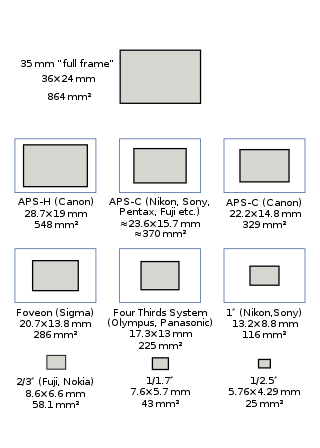
A full-frame DSLR is a digital single-lens reflex camera (DSLR) with a 35 mm image sensor format. Historically, 35 mm was one of the standard film formats, alongside larger ones, such as medium format and large format. The full-frame DSLR is in contrast to full-frame mirrorless interchangeable-lens cameras, and DSLR and mirrorless cameras with smaller sensors, much smaller than a full 35 mm frame. Many digital cameras, both compact and SLR models, use a smaller-than-35 mm frame as it is easier and cheaper to manufacture imaging sensors at a smaller size. Historically, the earliest digital SLR models, such as the Nikon NASA F4 or Kodak DCS 100, also used a smaller sensor.

The EasyShare P880 is a bridge digital camera from Kodak introduced on August 2, 2005, as part of Performance series. Its siblings are the P850 and the P712. The P880 possesses the largest optical sensor of all three models, with a size of 1/1.8 inches. Distinguishing features include wide-angle coverage of 24 mm, an on screen histogram display, and manual focus-by-wire. In terms of the Kodak product line and price the Performance series are the most sophisticated EasyShare cameras, just below the considerably more expensive Kodak professional DCS pro SLR digital cameras that were discontinued in May 2005.
The Kodak CX4230 is a model of digital camera produced by the Eastman Kodak Company. It is part of the company's EasyShare consumer line of cameras, and is compatible with the Kodak camera docks and printer docks. Its CCD image sensor gives a 2 megapixel image, while the fully retractable KODAK RETINAR lens has a focal length range equivalent to 36 mm–108 mm on a 35 mm film camera.
The Kodak EasyShare V570 was a 5-megapixel digital camera manufactured by Eastman Kodak. Announced on January 2, 2006, it was an upper-end model in the consumer price range, advertised at $400 in the United States in January 2006. It had an innovative dual lens system, combining two periscopic groups each with its own sensor: one very wide angle equivalent to a 23 mm in 135 format and a 3X zoom equivalent to a 39–117 mm, totalizing a virtual 5X zoom, with a step between 23 and 39 mm. It is the first dual lens digital camera. The model won a gold medal in the 2006 Industrial Design Excellence Awards.

The Olympus Camedia 310 Zoom is a self-contained color digital camera system, produced by the Olympus Optical Co., Ltd.
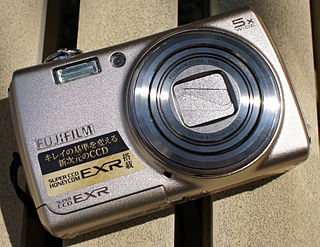
The Fujifilm FinePix F series is a line of compact digital cameras that was known for its low-light performance in 2005, with relatively low image noise and natural colors even at high ISO settings. With its relatively large, but moderate resolution Super CCD sensors, it concentrated on image quality, and low-light shooting without flash, which was mostly restricted to prosumer models at the time.
The Kodak EasyShare DX4530 is a digital camera made by Kodak, announced on Aug 5, 2003. Part of the DX Series of Kodak's EasyShare brand, its features include a 3x optical zoom and 10x zoom overall. The camera features a 5 megapixel CCD detector and supports six modes of operation: "sport" for use when the target is in motion, "night" for use in low light levels, "landscape" for use with distant scenery, "close up" for objects closer than 28 inches away, "auto" for general use, and "video" used to capture motion and sound.
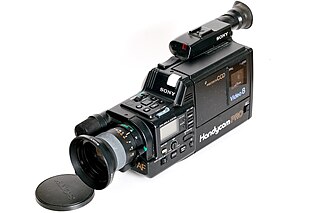
Sony Corporation produces professional, consumer, and prosumer camcorders such as studio and broadcast, digital cinema cameras, camcorders, pan-tilt-zoom and remote cameras.
General Imaging was a manufacturer of digital cameras headquartered in Torrance, California, established in 2006 by Hiroshi "Hugh" Komiya, a former executive of Olympus Corporation. General Imaging sold their cameras internationally under the General Electric name, used under license. In Japan, General Imaging was licensed to manufacture and sell their cameras under the AgfaPhoto name. General Imaging filed for bankruptcy on October 5, 2015.

Of the four new Kodak models announced at PMA 2007, the entry point looks to be the Kodak EasyShare C613, a six megapixel camera with Kodak-branded 3x optical zoom lens, 2.4" LCD, and 10MB of built-in memory. Other features of the Kodak C613 include USB connectivity, an [SD / MMC card slot], and power from two AA batteries.
This article discusses the cameras – mainly 35 mm SLRs – manufactured by Pentax Ricoh Imaging Corp. and its predecessors, Pentax Corporation and Asahi Optical Co., Ltd.. Pentax must not be confused with Pentax 6x7 or Pentax 67 which are 120 medium format 6x7cm film cameras.

The Kodak DC series was Kodak's pioneering consumer-grade line of digital cameras; as distinct from their much more expensive professional Kodak DCS series. Cameras in the DC series were manufactured and sold during the mid-to-late 1990s and early 2000s. Some were branded as "Digital Science". Most of these early digital cameras supported RS-232 serial port connections because USB hardware was not widely available before 1998. Some models in the DC series ran on the short lived DigitaOS, a camera operating system that allowed third party software to be installed.

The Nikon 1 series is a discontinued camera line from Nikon, originally announced on 21 September 2011. The cameras utilized Nikon 1-mount lenses, and featured 1" CX format sensors.
